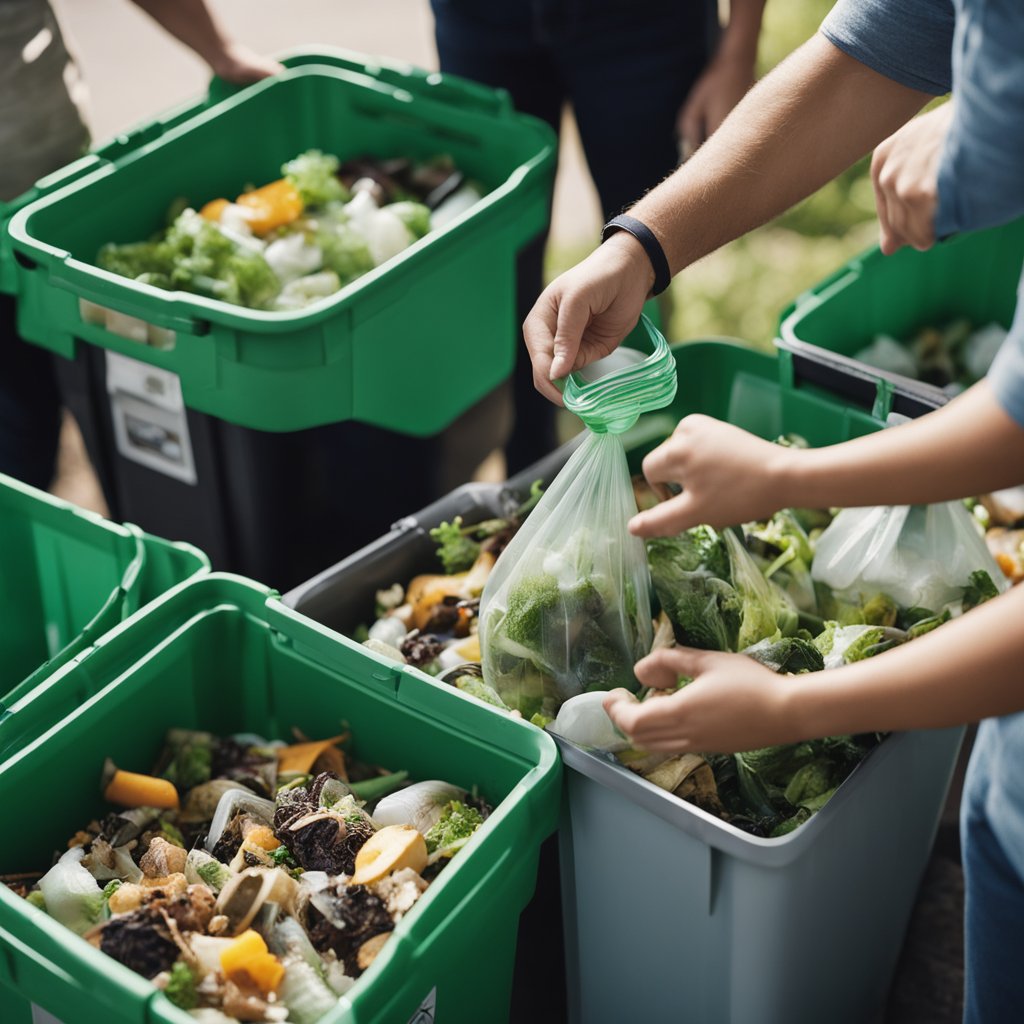Simple Tips for Recycling Properly and Reducing Waste Effectively
By Alex Reynolds |

Simple Tips for Recycling Properly and Reducing Waste Effectively
Recycling and reducing waste can feel overwhelming, but taking simple steps makes a big difference. Many people want to contribute to a cleaner planet but often struggle to know where to start. Understanding proper recycling methods and waste reduction techniques can empower everyone to make positive changes in daily life.
Implementing easy habits not only helps the environment but can also save money and promote sustainability. From sorting recyclables correctly to finding ways to repurpose items, small actions can lead to significant results. By adopting these practices, individuals can lessen their ecological footprint and inspire others to do the same.
Making informed choices about recycling and waste can foster a sense of community responsibility. By following straightforward tips, anyone can participate in efforts to protect the environment. The following tips will guide readers in making conscientious decisions that lead to a healthier planet.
Understanding Recycling
Recycling involves processing materials to create new products, which helps conserve resources and reduce waste. Understanding the different recyclable materials and their environmental benefits is crucial for effective recycling practices.
Different Types of Recyclable Materials
Not all materials can be recycled in the same way. Key types of recyclable materials include:
- Plastics: Many plastics, especially those marked with recycling codes #1 (PETE) and #2 (HDPE), are widely accepted.
- Metals: Aluminum and steel cans are easy to recycle, making them valuable resources.
- Paper: Recyclable paper includes newspapers, magazines, and cardboard, but contaminated paper may not be accepted.
- Glass: Clear, green, and brown glass bottles can be recycled repeatedly without degrading quality.
It’s important to check local recycling guidelines since different areas may have specific rules for what can be recycled. Proper sorting is key to reducing contamination and ensuring that materials are processed correctly.
Benefits of Recycling for the Environment
Recycling plays a vital role in protecting the environment. Here are some key benefits:
- Conserves Resources: Recycling reduces the need for raw materials, conserving natural resources like trees, minerals, and water.
- Reduces Waste: It keeps materials out of landfills, where they may take years to decompose. For example, recycling just one ton of paper can save 17 trees.
- Lowers Energy Consumption: Recycled materials often require less energy to process compared to producing new products from raw materials. This leads to lower greenhouse gas emissions.
- Promotes Sustainable Practices: Engaging in recycling fosters a culture of sustainability, encouraging individuals and businesses to adopt more eco-friendly behaviors.
Through understanding and practicing recycling, individuals can contribute meaningfully to environmental protection.
Setting Up a Home Recycling System
Creating a home recycling system can significantly cut down on waste. By choosing the right bins and following sorting guidelines, anyone can make recycling a simple part of daily life.
Essential Bins and Containers
To start the recycling process, it is vital to have the right bins. Essential bins include:
- Recycling Bin: A large container for mixed recyclables like paper, plastic, and metal.
- Compost Bin: For organic waste such as food scraps and yard waste.
- Trash Bin: For non-recyclable materials.
Consider color-coding these bins: blue for recycling, green for compost, and black for trash. This makes it easier to distinguish between them.
It is also helpful to have smaller containers in the kitchen for convenience. These can be emptied into larger bins regularly. Choose durable and easy-to-clean containers that can withstand daily use.
Labelling and Sorting Guidelines
Labels are crucial for a successful recycling system. Clear labels on each bin provide guidance on what items belong where. Use images along with text to show which materials go into each container. This simple step can greatly reduce confusion and contamination.
Sorting should be straightforward. Common recyclable materials include:
- Paper: Newspapers, cardboard, and office paper.
- Plastics: Bottles and containers marked with recycling symbols.
- Metals: Cans from beverages and food.
Avoid including items like greasy pizza boxes or plastic bags in the recycling bin, as they can cause issues at recycling facilities. By following these guidelines, it becomes much easier to recycle correctly and contribute to reducing waste.
Reducing Waste at the Source
Reducing waste at the source focuses on preventing waste before it happens. This can be achieved through mindful shopping and managing organic waste effectively. These strategies not only conserve resources but also lessen the environmental impact.
Smart Shopping to Reduce Packaging
Smart shopping involves making choices that limit unnecessary packaging. One effective approach is to purchase items in bulk. This can reduce the amount of plastic and cardboard waste generated from single-use packaging.
Tips for Smart Shopping:
- Choose Bulk Bins: Many stores offer bulk options, allowing for minimal packaging.
- Bring Your Own Bags: Using reusable bags cuts down on plastic use.
- Select Concentrated Products: Items like concentrated laundry detergents require less packaging.
Reading labels helps shoppers avoid products that use excessive packaging. Opting for brands that prioritize eco-friendly packaging can also support sustainability.
Composting Organic Waste
Composting is a practical way to manage organic waste. It turns items like fruit peels and coffee grounds into nutrient-rich soil. This reduces the amount of waste sent to landfills.
Steps for Successful Composting:
- Choose a Compost Bin: Select a bin that suits the space available.
- Collect Organic Waste: Gather kitchen scraps and yard waste.
- Layer Materials: Combines green materials (like fruit peels) with brown materials (like cardboard).
Regularly turning the compost pile ensures proper decomposition. By composting, one can significantly cut down on household waste, benefiting both the environment and garden.
Proper Disposal of Non-Recyclables
Disposing of non-recyclable items correctly is essential for effective waste management. Understanding which items cannot be recycled and how to handle hazardous waste ensures safety and environmental responsibility.
Identifying Non-Recyclable Items
Non-recyclable items are materials that cannot be processed in standard recycling systems. Common examples include:
- Plastic bags: These often jam recycling machinery.
- Styrofoam: This material does not break down efficiently and is not accepted by most programs.
- Food-contaminated items: Containers with leftover food cannot be recycled due to contamination.
- Certain plastics: Check local guidelines, as not all types of plastic can be recycled, especially those labeled with specific numbers.
Many municipalities provide lists of what can and cannot be recycled. Keeping informed helps reduce contamination and ensures that recyclable items are processed correctly.
Safe Handling of Hazardous Waste
Hazardous waste includes items that can be harmful to human health or the environment. Examples are batteries, paint, electronics, and chemicals. These materials should never be placed in regular trash or recycling bins.
To handle hazardous waste safely:
- Identify: Know which items in the household are considered hazardous.
- Store: Keep hazardous items in a secure, dry location away from children and pets.
- Dispose: Use community drop-off centers or special hazardous waste collection events to dispose of these items properly.
Following these steps protects both the community and the environment from unsafe disposal practices.
Recycling Dos and Don’ts
Proper recycling involves specific actions that help ensure materials are processed correctly. Knowing how to clean and prepare items before recycling, as well as avoiding common mistakes, can significantly impact recycling efforts.
How to Clean and Prepare Items
Cleaning items before recycling is essential. Rinse containers like bottles and jars to remove any food or liquid residue. This prevents contamination and helps facilities process recyclables more efficiently.
- Remove labels: It can also help to peel off labels, though many recycling facilities can handle them.
- Flatten boxes: Taking the time to flatten cardboard boxes saves space in recycling bins.
- Cap and lid policy: Check local guidelines; some areas allow caps to stay on, while others require removal.
Taking these steps makes a big difference in the recycling process.
Common Mistakes to Avoid
Avoiding common mistakes can enhance recycling efforts. Many people are unsure about what materials are recyclable.
- Wish-cycling: This is putting non-recyclables in the bin hoping they will be recycled. Items like pizza boxes, plastic bags, and certain types of foam are usually not accepted.
- Dirty items: Recycling items with food or liquid waste can contaminate the entire load.
- Not following local rules: Different areas have specific guidelines. Always check local recycling rules to ensure compliance.
By steering clear of these mistakes, individuals can contribute to more effective recycling practices.
Community and Governmental Support
Community and governmental support play a vital role in effective recycling and waste reduction. Understanding local recycling regulations and actively participating in community efforts can significantly enhance recycling practices.
Local Recycling Regulations and Resources
Communities often have specific recycling regulations that guide residents on what can and cannot be recycled. It’s essential for individuals to familiarize themselves with these rules to avoid contamination in recycling bins. Many municipalities offer detailed guides that outline acceptable materials.
Key Resources:
- Municipal Websites: Most local governments provide online resources detailing recycling guidelines.
- Collection Schedules: Many offer calendars to help residents know when to place their recyclables out for collection.
Additionally, local waste management offices can offer information regarding nearby recycling centers or special collection events. Engaging with these resources ensures everyone follows the same standards, improving the recycling process for all.
Getting Involved with Community Efforts
Participating in community recycling programs can have a substantial impact. Residents can join local initiatives focused on waste reduction, such as neighborhood clean-up events or educational workshops.
Ways to Get Involved:
- Volunteering: Help organize local recycling drives or educational sessions in schools.
- Community Groups: Join or form groups that focus on sustainability and recycling advocacy.
These collective efforts create a culture of recycling and responsible waste management. Engaging with local government initiatives also maximizes effectiveness, as established programs often need community support to thrive and reach their goals.
Innovations in Recycling
Recycling is evolving through new technologies and sustainable practices. These innovations aim to improve efficiency, reduce waste, and enhance recovery rates, making recycling systems more effective.
Technological Advances
Modern technologies are transforming recycling processes. Automated sorting systems are now capable of accurately identifying recyclable materials. This leads to higher recovery rates and reduced contamination.
Examples of technology in recycling:
- Robotic Sorters: These machines use AI to sort recyclables faster and more accurately.
- Advanced Materials Recovery Facilities (MRFs): These facilities use a mix of screens, magnets, and air classifiers to separate materials efficiently.
Additionally, innovations in digital tracking allow for better management of recycling supply chains. Systems can monitor materials throughout their journey, ensuring more items are collected and processed correctly.
Sustainable Practices and Business Models
Many businesses are adopting sustainable practices in recycling. A growing trend is the circular economy, where companies design products with recycling in mind. This reduces waste and promotes resource efficiency.
Key sustainable practices include:
- Product Redesign: Manufacturers are creating products that are easier to disassemble and recycle.
- Take-Back Programs: Companies are encouraging consumers to return products for recycling, ensuring more materials are reused.
Moreover, partnerships between businesses and recycling facilities foster innovation. Collaborations help develop new recycling methods and improve material recovery. This shift toward sustainability supports not only environmental goals but also economic growth in the recycling industry.
Frequently Asked Questions
Recycling and waste reduction can seem challenging, but with the right strategies, it becomes manageable. Understanding how to start and maintain these practices can lead to meaningful changes in everyday life.
What are the top strategies for recycling effectively at home?
Effective recycling at home starts with proper sorting. Materials like paper, plastics, and metals should be separated. Using labeled bins for each material helps everyone in the household know what goes where.
Cleaning recyclables before placing them in bins is crucial. Residual food or liquid can contaminate the entire batch, making it unsuitable for recycling.
Keeping a checklist of recyclable items visible can serve as a helpful guide. This ensures that all household members are aware of what materials are acceptable.
How can I start recycling as a beginner?
Starting to recycle can be simple. Firstly, a person should identify recycling facilities in their area and understand what they accept. Most local garbage collectors provide guidelines on recycling.
Next, they can set up a designated space for recyclables at home. Tools like bins or containers can help keep everything organized.
It’s useful to begin with easy items, like paper and bottles. This approach builds confidence for tackling more complex materials.
What are the key habits to adopt for reducing household waste?
Developing habits that reduce waste starts with mindful consumption. She or he should consider purchasing products with minimal packaging.
Using reusable bags, bottles, and containers significantly cuts down on single-use items. This choice not only saves money but also helps the environment.
Practicing meal planning can reduce food waste. By buying only what is needed, less food goes uneaten and wasted.
In what ways can waste reduction be implemented in daily life?
Waste reduction can fit into daily routines easily. For example, opting for digital bills minimizes paper waste.
Composting food scraps is another effective method. It not only reduces landfill contributions but also provides great nutrients for gardens.
Encouraging a culture of sharing instead of discarding items can also help. Community sharing events enable people to exchange goods, reducing the need to buy new products.
What are the most effective methods to minimize waste in the kitchen?
In the kitchen, meal prepping allows for efficient use of ingredients. By planning meals in advance, it reduces old food items being thrown away.
Using airtight containers helps preserve food for longer periods, decreasing spoilage. This simple step can save both money and waste.
Regularly checking the pantry and fridge for expiring items can prompt timely uses, cutting down on forgotten food.
Can you suggest practical tips for promoting recycling in the workplace?
Promoting recycling in the workplace can start with proper signage. Clearly labeled recycling bins encourage employees to dispose of items correctly.
Hosting training sessions on recycling best practices raises awareness. Employees learning about what can and cannot be recycled makes a big difference.
Setting up a rewards system can motivate staff participation. Recognizing those who actively engage in recycling fosters a positive culture around waste reduction.


